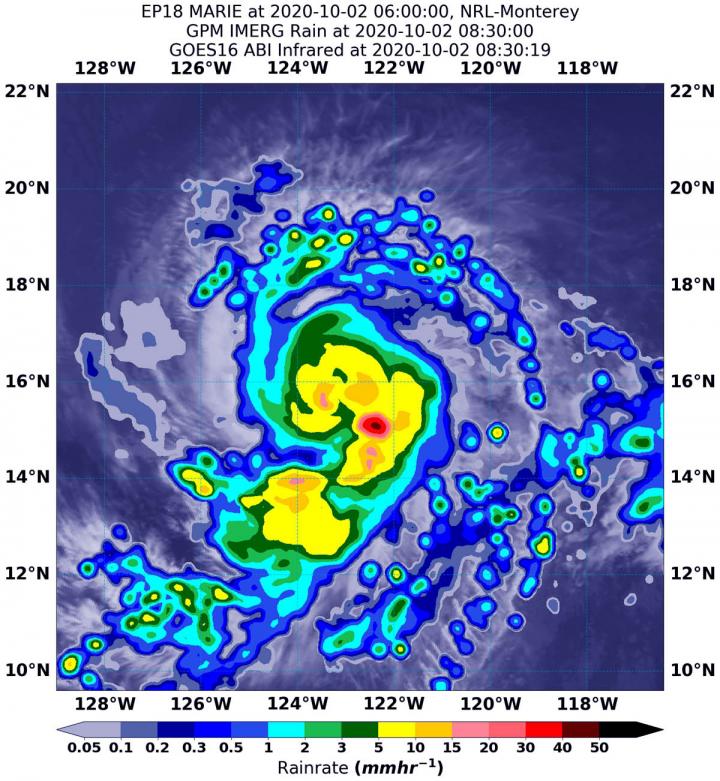
Photo: On Oct. 2 at 4:30 a.m. EDT (0830 UTC), NASA’s IMERG estimated Hurricane Maria was generating as much as 50 mm (2 inches of rain/dark red) around the center of…
view more
Credit Image: NASA/NOAA/NRL
Imagine being able to look down at a storm from orbit in space, and provide data that lets scientists calculate the rate in which rain is falling throughout it. That is what a NASA satellite rainfall product does as it incorporates data from satellites and observations. NASA found very heavy rainfall ringing around the compact eye of Major Hurricane Marie.
Maria’s Status on Oct. 2
At 5 a.m. EDT (0900 UTC), NOAA’s National Hurricane Center (NHC) reported Hurricane Marie was a Category 4 storm on the Saffir-Simpson Hurricane Wind Scale. The center of Hurricane Marie was located near latitude 16.2 degrees north and longitude 123.2 degrees west. Fortunately, Marie is far from land areas. It is centered about 980 miles (1,580 km) west-southwest of the southern tip of Baja California, Mexico.
Marie was moving toward the west-northwest near 15 mph (24 kph). Maximum sustained winds have increased to near 130 mph (215 kph) with higher gusts. Hurricane-force winds extend outward up to 25 miles (35 km) from the center and tropical-storm-force winds extend outward up to 125 miles (205 km). The estimated minimum central pressure is 947 millibars.
Estimating Maria’s Rainfall Rates from Space
NASA’s Integrated Multi-satellitE Retrievals for GPM or IMERG, which is a NASA satellite rainfall product, estimated on Oct. 2 at 4:30 a.m. EDT (0830 UTC), Hurricane Maria was generating as much as 50 mm (2 inches) of rain in the eyewall, ringing around the eye. Rainfall throughout most of the storm was occurring between 3 and 20 mm (0.1 to 0.8 inches) per hour.
At the U.S. Naval Laboratory in Washington, D.C., the IMERG rainfall data was overlaid on infrared imagery from NOAA’s GOES-16 satellite to provide a full picture of the storm.
What Does IMERG Do?
This near-real time rainfall estimate comes from the NASA’s IMERG, which combines observations from a fleet of satellites, in near-real time, to provide near-global estimates of precipitation every 30 minutes. By combining NASA precipitation estimates with other data sources, we can gain a greater understanding of major storms that affect our planet.
Instead, what the IMERG does is “morph” high-quality satellite observations along the direction of the steering winds to deliver information about rain at times and places where such satellite overflights did not occur. Information morphing is particularly important over the majority of the world’s surface that lacks ground-radar coverage. Basically, IMERG fills in the blanks between weather observation stations.
Marie’s Future
Additional strengthening is expected today, with weakening forecast to begin on Saturday, Oct. 3. A motion toward the west-northwest or northwest with a gradual decrease in forward speed is expected during the next several days.
###
NASA Researches Tropical Cyclones
Hurricanes/tropical cyclones are the most powerful weather events on Earth. NASA’s expertise in space and scientific exploration contributes to essential services provided to the American people by other federal agencies, such as hurricane weather forecasting.
For more than five decades, NASA has used the vantage point of space to understand and explore our home planet, improve lives and safeguard our future. NASA brings together technology, science, and unique global Earth observations to provide societal benefits and strengthen our nation. Advancing knowledge of our home planet contributes directly to America’s leadership in space and scientific exploration.
For more information about NASA’s IMERG, visit: https:/
For forecast updates on hurricanes, visit: http://www.
By Rob Gutro
NASA’s Goddard Space Flight Center
TDnews (tunisiesoir.com)















